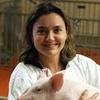Explore all the information on
Swine influenza
Welcome to the page about Swine influenza of Engormix; a source of knowledge on Swine influenza.
Introduction: When pathogens become airborne, they travel associated with particles of different size and composition. Particle size determines the distance across which pathogens can be transported, as well as the site of deposition and the survivability of the pathogen. Despite the importance of this information, the size distribution of particles bearing viruses emitted by infectious animals remains unknown. In this study, we characterized the concentration and size...
Comments : 0
Recommendations: 0
Introduction: Swine influenza outbreaks are usually recognized by the sudden appearance of respiratory signs and also by quick recovery of sick animals. However, influenza A virus (IAV) can endemically circulate without causing such typical clinical outbreaks. In addition, the complexity of influenza circulation in large multi-site and multi-source herds has not been well described. The objectives of this study were to describe the dynamics of IAV circulation in...
Comments : 0
Recommendations: 0
Recommended events
May 14, 2024
Canada - Manitoba - Winnipeg
Introduction: Influenza A virus (IAV) is an important pathogen in swine, and the main intervention strategy is vaccination to induce neutralizing antibodies against the hemagglutinin (HA). Three major antigenic clusters, cyan, red, and green, were identified among H3N2 viruses circulating in pigs in the U.S. and were associated with amino acid changes in 6 key sites in the HA protein. In this study, we compared the efficacy of different vaccine platforms including...
Comments : 0
Recommendations: 0
Introduction: Recurrent influenza infections in swine herds are characterized by swine influenza A virus (swIAV) infections occurring at a fixed age in successive batches, when a significant part of the piglets still have swIAV maternally derived antibodies (MDAs). Although passive immunity is known to provide partial protection against infection, its impact on transmission is not fully understood. The present study aimed at estimating the protective impact of MDAs derived from...
Comments : 0
Recommendations: 0
Introduction: Recent studies have identified a novel influenza virus circulating in swine and cattle. The virus, distantly related to human influenza C virus, has been provisionally designated as influenza D virus (IDV) and a new genus of the Orthomyxoviridae family was proposed. This novel virus was identified for the first time in pigs with influenza-like illness, but subsequent serologic and virological studies conducted in USA and in France have suggested cattle as...
Comments : 0
Recommendations: 0
Introduction: Over the last 15 years, genetically and antigenically distinct groups of influenza A viruses in swine (IAV-S) have emerged. The 2009 pandemic H1N1 virus and variant H3N2 viruses of swine-origin underscore the threat that IAV-S pose to public health. Consequently, there is greater need for increased IAV-S surveillance globally. This is particularly important in regions where there is very little historical sequence data available. In this study, IAV-S surveillance...
Comments : 0
Recommendations: 0
Introduction: In situ hybridization (ISH) is a nucleic acid-based method that allows the detection of a particular RNA or DNA sequence within the tissue sections. A novel ISH RNA-based chromogenic technique (RNAScope) describes single-molecule visualization through the use of hybridization-based signal amplification system. These characteristics make this platform a promising diagnostic approach, especially by improving sensitivities issues faced by classical ISH...
Comments : 0
Recommendations: 0
...
Comments : 0
Recommendations: 0
Over the last 30 years, diseases caused by emerging swine viruses (ESV) have acquired great relevance, more than in other species. Diseases caused by porcine reproductive and respiratory syndrome virus (PRRSv), high pathogenicity porcine epidemic diarrhea virus (PEDv), porcine circovirus type 2 (PCV-2), and influenza virus H1N1pdm09 had great economic impact. Others, however, such as porcine enteroviruses, porcine toroviruses (PToV), porcine sapelovirus (PSV), porcine bocavirus (PBoV),...
Comments : 0
Recommendations: 0
...
Comments : 0
Recommendations: 0
Introduction Influenza A viruses (IAV) are the causative agents of one of the most important viral respiratory diseases in pigs and humans. Human and swine IAV are prone to interspecies transmission, leading to regular incursions from human to pig and vice versa. This bidirectional transmission of IAV has heavily influenced the evolutionary history of IAV in both species. Interspecies transmission of distinct human seasonal lineages, adaptation followed by...
Comments : 0
Recommendations: 0
INTRODUCTION In 2016, 63% of U.S. market hog sales originated in Iowa and the surrounding six states (USDA, 2017). While Midwest swine production is in a unique position of being favorably located geographically, such density increases the risk of disease transmission among farms. Porcine reproductive and respiratory syndrome virus ( PRRSV) is the costliest disease facing pig producers. Holtkamp et al. (2013) estimated annual losses of 664 million U.S. dollar...
Comments : 0
Recommendations: 1
Influenza A virus (IAV) is a member of the family Orthomyxoviridae possessing 8 negative sense single-stranded RNA segments and classified in subtypes based on the antigenicity of their surface glycoproteins: 18 subtypes for hemagglutinin (HA) and 11 subtypes for neuraminidase (NA). IAV can infect birds and several mammalian species, including human and swine. Pigs have an important role in the ecology of IAV, since they can become infected with both human and avian strains. Co-infection...
Comments : 0
Recommendations: 0
Outbreaks of avian and swine influenza, as well as African swine fever in Asia, are forcing scientists to reevaluate and redirect their research towards a stronger strengthening of the immune system through nutrition. Immunonutrition is the study of the relationship between...
Comments : 5
Recommendations: 4
1. Introduction In April 2009, Edgar Hernández, a four year-old boy from La Gloria, El Perote in Veracruz, Mexico, was declared the first human infected with a new kind of virus that caused a type of pneumonia or severe flu. Within a few days, other residents from the same community presented the symptoms of the new disease. Since the village is 8.5 kilometers far from Carroll Farms –a subsidiary of Smithfield Foods, one of the major US swine producer–, it was...
Comments : 0
Recommendations: 0
Introduction Globalization has played an important role in the dissemination of diseases because it allows the mobilization of people, animals and products from one place to another in a short time1. In addition, population growth, deforestation, the introduction of exotic species, changes in land use, habitat fragmentation and alternative tourism have increased the possibility of contact with wild animals, and their consumption by human2. Interactions within the human-animal...
Comments : 0
Recommendations: 0
Cross-species infections with influenza A viruses readily occur between humans and pigs. Pigs often have been infected by human epidemic viruses (1), and swine workers and their family members are at increased risk for swine influenza virus (SIV) infection (2–4). We studied swine shows as a setting for influenza A virus transmission (5). The Study ...
Comments : 0
Recommendations: 0
Introduction Swine influenza is an acute respiratory disease caused by swine influenza viruses (SIV). The symptoms and signs generally include fever, sneezing, nasal rattles, and respiratory distress in pigs. Pigs recover within a few days, but severe signs can develop and mortality can reach up to 10%when highly virulent strains are involved [1] or pigs are infected at young ages [2,3]. Pigs have long been considered to be the intermediate host of various subtype viruses and...
Comments : 0
Recommendations: 0
Influenza A virus has become a major pathogen, causing epidemics of respiratory disease in humans, which not only result in increased deaths but also raise public health organization alarms regarding the need for further understanding and control of this virus (1). Additionally, the ability of the virus to cross species barriers has raised more concern over the probability of reassortment and generation of highly transmissible viruses that might pose a threat to...
Comments : 0
Recommendations: 0
Influenza A viruses (IAVs) are the etiologic agents of acute respiratory disease in many mammalian species. Although originating in wild aquatic birds, IAVs have been successful in crossing the species barrier, and specific subtypes have become endemic among humans and domestic swine populations (1). In the United States, influenza was first described in swine herds during the 1918 pandemic and has circulated among domestic pigs for nearly a century (2). The...
Comments : 0
Recommendations: 0
















